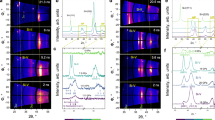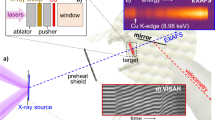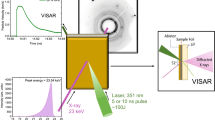Abstract
Silicon, being one of the most abundant elements in nature, attracts wide-ranging scientific and technological interest. Specifically, in its elemental form, crystals of remarkable purity can be produced. One may assume that this would lead to silicon being well understood, and indeed, this is the case for many ambient properties, as well as for higher-pressure behaviour under quasi-static loading. However, despite many decades of study, a detailed understanding of the response of silicon to rapid compression—such as that experienced under shock impact—remains elusive. Here, we combine a novel free-electron laser-based X-ray diffraction geometry with laser-driven compression to elucidate the importance of shear generated during shock compression on the occurrence of phase transitions. We observe lowering of the hydrostatic phase boundary in elemental silicon, an ideal model system for investigating high-strength materials, analogous to planetary constituents. Moreover, we unambiguously determine the onset of melting above 14 GPa, previously ascribed to a solid–solid phase transition, undetectable in the now conventional shocked diffraction geometry; transitions to the liquid state are expected to be ubiquitous in all systems at sufficiently high pressures and temperatures.
This is a preview of subscription content, access via your institution
Access options
Access Nature and 54 other Nature Portfolio journals
Get Nature+, our best-value online-access subscription
$29.99 / 30 days
cancel any time
Subscribe to this journal
Receive 12 print issues and online access
$209.00 per year
only $17.42 per issue
Buy this article
- Purchase on Springer Link
- Instant access to full article PDF
Prices may be subject to local taxes which are calculated during checkout




Similar content being viewed by others
Data availability
The data that support the plots within this paper and other findings of this study are available from the corresponding author upon reasonable request
References
Bancroft, D., Peterson, E. L. & Minshall, S. Polymorphism of iron at high pressure. J. Appl. Phys. 27, 291–298 (1956).
Colburn, N. L., Forbes, J. W. & Jones, H. D. Electrical measurements in silicon under shock-wave compression. J. Appl. Phys. 43, 5007–5012 (1972).
Smith, R. F. et al. Orientation and rate dependence in high strain-rate compression of single-crystal silicon. Phys. Rev. B 86, 245204 (2012).
Gust, W. H. & Royce, E. B. Axial yield strengths and two successive phase transition stresses for crystalline silicon. J. Appl. Phys. 42, 1897–1905 (1971).
Goto, T., Sato, T. & Syono, Y. Reduction of shear strength and phase-transition in shock-loaded silicon. Jpn. J. Appl. Phys. 21, L369–L371 (1982).
Turneaure, S. J. & Gupta, Y. M. Inelastic deformation and phase transformation of shock compressed silicon single crystals. Appl. Phys. Lett. 91, 201913 (2007).
Smith, R. F. et al. Ultrafast dynamic compression technique to study the kinetics of phase transformations in bismuth. Phys. Rev. Lett. 101, 065701 (2008).
Smith, R. F. et al. Time-dependence of the alpha to epsilon phase transformation in iron. J. Appl. Phys. 114, 223507 (2013).
Higginbotham, A. et al. Inelastic response of silicon to shock compression. Sci. Rep. 6, 24211 (2016).
Jamieson, J. C. Crystal structures at high pressures of metallic modifications of silicon and germanium. Science 139, 762–764 (1963).
McMahon, M. I. & Nelmes, R. J. New high-pressure phase of Si. Phys. Rev. B 47, 8337–8340 (1993).
McMahon, M. I., Nelmes, R. J., Wright, N. G. & Allan, D. R. Pressure dependence of the Imma phase of silicon. Phys. Rev. B 50, 739–743 (1994).
Olijnyk, H., Sikka, S. K. & Holzapfel, W. B. Structural phase transitions in Si and Ge under pressures up to 50 GPa. Phys. Lett. A 103, 137–140 (1984).
Duclos, S. J., Vohra, Y. K. & Ruoff, A. L. hcp-to-fcc transition in silicon at 78 GPa and studies to 100 GPa. Phys. Rev. Lett. 58, 775–777 (1987).
Hanfland, M., Schwarz, U., Syassen, K. & Takemura, K. Crystal structure of the high-pressure phase silicon VI. Phys. Rev. Lett. 82, 1197–1200 (1999).
Wentorf, R. H. & Kasper, J. S. Two new forms of silicon. Science 139, 338–339 (1963).
Piltz, R. O. et al. Structure and properties of silicon XII: A complex tetrahedrally bonded phase. Phys. Rev. B 52, 4072–4085 (1995).
Mogni, G., Higginbotham, A., Gaál-Nagy, K., Park, N. & Wark, J. S. Molecular dynamics simulations of shock-compressed single-crystal silicon. Phys. Rev. B 89, 064104 (2014).
Nagler, B. et al. The Matter in Extreme Conditions instrument at the Linac Coherent Light Source. J. Synchrotron. Radiat. 22, 520–525 (2015).
Fletcher, L. B. et al. Ultrabright X-ray laser scattering for dynamic warm dense matter physics. Nat. Photon. 9, 274–279 (2015).
Gorman, M. G. et al. Direct observation of melting in shock-compressed bismuth with femtosecond X-ray diffraction. Phys. Rev. Lett. 115, 095701 (2015).
Gleason, A. E. et al. Ultrafast visualization of crystallization and grain growth in shock-compressed SiO2. Nat. Commun. 6, 8191 (2015).
Harmand, M. et al. X-ray absorption spectroscopy of iron at multimegabar pressures in laser shock experiments. Phys. Rev. B 92, 024108 (2015).
Kraus, D. et al. Nanosecond formation of diamond and ionsdaleite by shock compression of graphite. Nat. Commun. 7, 10970 (2016).
Rygg, J. R. et al. Powder diffraction from solids in the terapascal regime. Rev. Sci. Inst. 83, 113904 (2012).
Coppari, F. et al. Experimental evidence for a phase transition in magnesium oxide at exoplanet pressures. Nat. Geosci. 6, 926–929 (2013).
Lazicki, A. et al. X-ray diffraction of solid tin to 1.2 TPa. Phys. Rev. Lett. 115, 075502 (2015).
Wang, J. et al. X-ray diffraction of molybdenum under shock compression to 450 GPa. Phys. Rev. B 92, 174114 (2015).
Le Bail, A. L. Whole powder pattern decomposition methods and applications: a retrospection. Powder Diffr. 20, 316–326 (2005).
Cheng, C., Huang, W. H. & Li, H. J. Thermodynamics of uniaxial phase transition: Ab initio study of the diamond-to-β-tin transition in Si and Ge. Phys. Rev. B 63, 153202 (2001).
Gupta, M. C. & Ruoff, A. L. Static compression of silicon in the [100] and in the [111] directions. J. Appl. Phys. 51, 1072–1075 (1980).
Lewis, S. P. & Cohen, M. L. Theoretical study of high-pressure orthorhombic silicon. Phys. Rev. B 48, 16144–16147 (1993).
Funamori, N. & Tsuji, K. Pressure-induced structural changes of liquid silicon. Phys. Rev. Lett. 88, 255508 (2002).
Daisenberger, D. et al. High-pressure X-ray scattering and computer simulation studies of density-induced polyamorphism in silicon. Phys. Rev. B 75, 224118 (2007).
Eggert, J. H. et al. Melting temperature of diamond at ultrahigh pressure. Nat. Phys. 6, 40–43 (2010).
Hahn, E. N., Zhao, S., Bringa, E. M. & Meyers, M. A. Supersonic dislocation bursts in silicon. Sci. Rep. 6, 26977 (2016).
Zhao, S. et al. Pressure and shear-induced amorphization of silicon. Extreme Mech. Lett. 5, 74–80 (2015).
Turneaure, S. J., Sinclair, N. & Gupta, Y. M. Real-time examination of atomistic mechanisms during shock-induced structural transformation in silicon. Phys. Rev. Lett. 117, 045502 (2016).
Strickson, O. & Artacho, E. Ab initio calculation of the shock Hugoniot of bulk silicon. Phys. Rev. B 93, 094107 (2016).
Dixit, S. N., Lawson, J. K., Manes, K. R. & Powell, H. T. Kinoform phase plates for focal plane irradiance profile control. Opt. Lett. 19, 417–419 (1994).
Acknowledgements
E.E.M and A.S. acknowledge funding from the Volkswagen Foundation. J.S.W. is grateful for support from EPSRC under grant EP/J017256/1. This work is supported by the French Agence Nationale de la Recherche (ANR) with the ANR IRONFEL 12-PDOC-0011. Use of the Linac Coherent Light Source (LCLS), SLAC National Accelerator Laboratory, is supported by the US Department of Energy, Office of Science, Office of Basic Energy Sciences under Contract No. DE-AC02-76SF00515. The MEC instrument is supported by the US Department of Energy, Office of Science, Office of Fusion Energy Sciences under contract No. SF00515. The authors thank J. B. Hastings and L. B. Fletcher for a critical review of the manuscript.
Author information
Authors and Affiliations
Contributions
E.E.M., A.H. and A.N. designed the experiment, E.E.M., A.H., D.S. and C.S. designed the targets and C.S. manufactured the targets. E.E.M., A.K., M.H., E.G., Z.K., H-.J.L., B.N., A.P., M.R., A.S., C.S., F.T., S.T., T.T. and A.H. contributed to the set-up of the experiment and data collection. E.E.M. analysed the data, with assistance from A.K., M.H., R.F.S. and A.H., then E.E.M. and A.H. interpreted the data. E.E.M., A.H. and J.S.W. wrote the manuscript. All authors commented critically on the manuscript.
Corresponding author
Ethics declarations
Competing interests
The authors declare no competing interests.
Additional information
Publisher’s note: Springer Nature remains neutral with regard to jurisdictional claims in published maps and institutional affiliations.
Supplementary information
Supplementary Information
8 chapters, 15 figures, 41 references
Rights and permissions
About this article
Cite this article
McBride, E.E., Krygier, A., Ehnes, A. et al. Phase transition lowering in dynamically compressed silicon. Nature Phys 15, 89–94 (2019). https://doi.org/10.1038/s41567-018-0290-x
Received:
Accepted:
Published:
Issue Date:
DOI: https://doi.org/10.1038/s41567-018-0290-x
This article is cited by
-
Materials under extreme conditions using large X-ray facilities
Nature Reviews Methods Primers (2023)
-
Single-shot X-ray absorption spectroscopy at X-ray free electron lasers
Scientific Reports (2023)
-
Dynamics of ultrafast phase transitions in MgF2 triggered by laser-induced THz coherent phonons
Scientific Reports (2022)
-
Phase transformation path in Aluminum under ramp compression; simulation and experimental study
Scientific Reports (2022)
-
Atomistic deformation mechanism of silicon under laser-driven shock compression
Nature Communications (2022)



